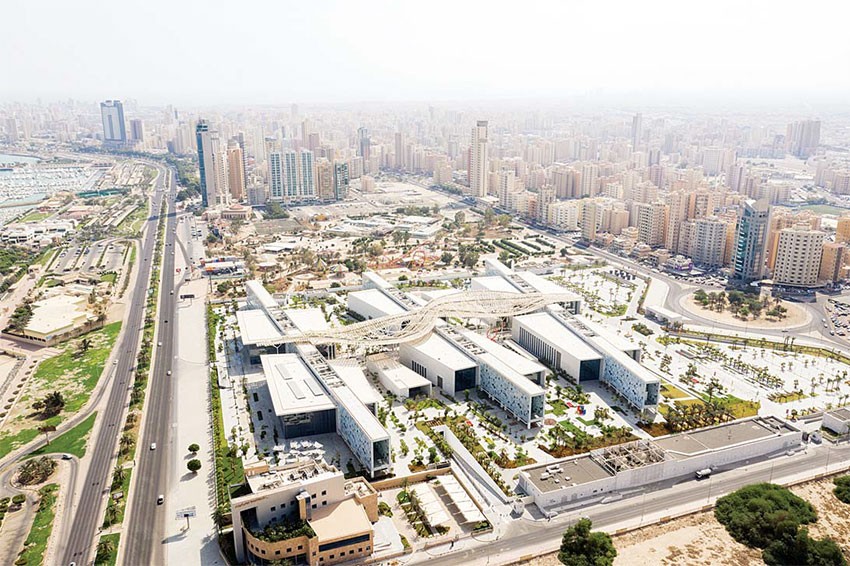13/06/2021
13/06/2021
KUWAIT CITY, June 13 Governor of the Central Bank of Kuwait, Dr. Mohammad Y. Al-Hashel announced the publication of the 49th issue of the Economic Report, published annually by the Central Bank of Kuwait (CBK). The 2020 Economic Report covers key economic developments, including the most recent data and statistics available on various aspects of economic performance in the State of Kuwait during said year. The report addresses these developments in six parts, each covering a major topic in detail. The global economy suffered an exceptionally tough year due to the COVID-19 pandemic that caused the worst economic shock in a century. Precautionary and preventative measures went as far as total shut down of many economic activities in the first and second waves of the pandemic, putting a hard stop to a considerable portion of economic activity locally and abroad, shocking supply and demand.
to the pandemic and its serious ramifications, the International Monetary Fund (IMF) estimates that the global economy had retracted by 3.3% in 2020 compared to a growth of 2.8% in 2019. As global and regional economies suffered recessions, a retraction in both global demand for oil and in oil prices, directly or indirectly affected aspects of economic activity in the State of Kuwait. Initial estimates indicate that Gross Domestic Product (GDP) at constant prices for the Sate of Kuwait has dropped by an average of 9.9% in 2020 compared to an average growth of 0.4% in 2019. The value of GDP at current prices also dropped by almost 23.2%, mainly driven by a drop in the average price of Kuwait’s Export Crude (KEC) per barrel to USD 41.5 in 2020, slipping 35.2%. The inflation rate measured by the Consumer Price Index (CPI) came up to 2.1% in 2020 compared to an increase of 1.1% in 2019. Available data also indicate a drop in the total population by end of 2020 by 2.2% compared to a growth of 3.3% at end of 2019.

Responded
In terms of monetary and banking developments in 2020, Central Bank of Kuwait (CBK) swiftly and decisively responded through monetary and prudential policies since the onset of the pandemic. The Bank dedicated its efforts and resources to counteract the negative effects of the pandemic, and did not hesitate to utilize all tools at its disposal without abandoning its goals aimed at maintaining the atmosphere of monetary stability and financial stability. The CBK adopted extraordinary accommodative policies to support sectors of the economy and help them weather the storm, focusing on the need to provide an environment that builds confidence in the national economy and its ability to recover.
The Bank took a swift pre-emptive monetary decision in March 2020 lowering the Discount Rate to a historical low of 1.5%, followed with a reduction in the Repo Rate as well as monetary market intervention price. This resulted in a drop in all indicators of local interest rates for 2020 compared to the year before. On the supervision and banking regulation front, in support of individuals and of small and medium enterprises and companies negatively affected by the crisis, and to help the banking sector counter shocks experienced in 2020, the CBK adjusted its instructions and its macro-prudential instruments by reducing regulatory ratio requirements in terms of liquidity, capital adequacy, and lending ratios. This policy relaxation as well as the banks’ resilience, capitalization and liquidity, owing to prudent CBK monetary and supervisory policies, enabled them to fulfill their vital role in the economy and encouraged them to extend more loans and financing.
As for the exchange rate, the Kuwaiti Dinar remained relatively stable against main currencies within its peg to a special weighted basket of currencies of Kuwait’s main trade and finance partners. Stimulatory monetary policy interventions and CBK prudential polices boosted confidence and warded off credit crises, and also provided sufficient liquidity to support economic recovery. Indicators reflected the banking sector’s performance, most especially for the second half of 2020, with the credit awarded to the private sector growing by end of year. The growth tempo in local liquidity levels for said year increased. Money Supply in the broad sense (M2) went up 3.8% compared to its drop of 1.2% the year before. Residents’ deposits with local banks continued to make faster growth, going up 3.8% compared to 0.3% the year before. And despite slower growth in the balance of local credit in 2020, growth remained positive reaching 3.5% despite the lockdown. The continued positive growth rate of credit facilities is undoubtedly indicative of the efficacy of the CBK accommodative monetary policy measures. Looking at the Current Account of the State of Kuwait’s Balance of Payments, the figures show a realized surplus of KD 6,849.9 million for the first three quarters of 2020, at a drop of KD 390.6 million or 5.4% against the corresponding period of the previous year. (KUNA)


